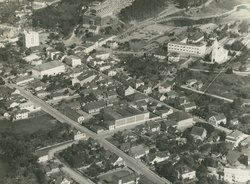Brusque (Santa Catarina)
| Município de Brusque "Cidade dos Tecidos"
Brusque
|
|||
|---|---|---|---|
|
View of the center
|
|||
|
|
|||
| Coordinates | 27 ° 6 ′ S , 48 ° 55 ′ W | ||
 Location of the municipality of Brusque in the state of Santa Catarina Location of the municipality of Brusque in the state of Santa Catarina
|
|||
| Symbols | |||
|
|||
| founding | August 4, 1860 (as Vila and Colony) March 23, 1881 (as São Luis Gonzaga) |
||
| Basic data | |||
| Country | Brazil | ||
| State | Santa Catarina | ||
| ISO 3166-2 | BR-SC | ||
| height | 21 m | ||
| Waters | Rio Itajaí-Mirim | ||
| climate | subtropical, Cfa | ||
| surface | 283.2 km² | ||
| Residents | 105,503 (2010) | ||
| density | 372.5 Ew. / km² | ||
| estimate | 131,703 (July 1, 2018) | ||
| Parish code | IBGE : 4202909 | ||
| Time zone | UTC −3 | ||
| Website | brusque.atende.net (Brazilian Portuguese) | ||
| politics | |||
| City Prefect | Jonas Oscar Paegle (2017-2020) | ||
| Political party | Partido Socialista Brasileiro (PSB) | ||
| Culture | |||
| City festival | August 4th (foundation festival) | ||
| economy | |||
| GDP | 5,034,195 thousand R $ 41,003 R $ per capita (2015) |
||
| HDI | 0.795 (2010) | ||
Brusque , officially Portuguese Município de Brusque , is a fast growing medium-sized town in the state of Santa Catarina in the south of Brazil and is located on the banks of the Itajaí-Mirim river between the cities of Blumenau in the northwest and Itajaí in the northeast and is one of the three along with Joinville and Blumenau Centers of German colonization in Santa Catarina. As of July 1, 2018, the population was estimated at 131,703 people who call themselves brusquenses (Brusquensians) and live in an area of around 283.2 km². The distance to the capital Florianópolis is 99 km.
History and urban development
The city was founded in 1860 as Vila do Itajahy with the Colônia Itajahy (Colony Itajahy) as the founding core as a result of the second wave of Germans immigrating to Brazil from 1845 to 1859 . Emigrants from Schleswig-Holstein , Pomerania and Baden settled in Brusque . After 1875, Italians and Poles also settled here.
When the city was founded in 1860, 54 German families lived in Brusque. In 1887, 11,000 people lived in the village. In 2000 the population had already risen to 70,000.
economy
Brusque is known as "The cradle of spinning and weaving of Santa Catarina" and "The city of textiles". Because Brusque is the main center for the manufacture of textile goods in southern Brazil, especially clothing .
There are three breweries in the city: "Cervejaria do Lalo", "Cervejaria Ten Beer" and "Cervejaria Ten Beer II".
Sights and events
Sights in Brusque are the Azambuja Church, the São Luis Gonzaga Cathedral and the Azambuja Museum ( Museu de Azambuja ). There is also an astronomical observatory there, which is considered to be one of the best in Brazil.
Since 1986 the "Fenarreco" takes place every year in October. It is considered a typically German festival; in 2012 it attracted more than 115,000 visitors.
sons and daughters of the town
- Lindolfo Weingärtner (* 1923), Lutheran pastor, professor of practical theology, writer and poet
- Wolfgang Richter (* 1928), German Old Testament scholar
- Edino Krieger (* 1928), violinist, composer and conductor
- Murilo Sebastião Ramos Krieger (* 1943), Roman Catholic clergyman, Archbishop of São Salvador da Bahia and Primate of Brazil
- César Moritz (* 1948), politician
- Murilo Fischer (* 1979), racing cyclist
- Evaeverson Lemos da Silva , called Brandão (* 1980), football player
Web links
- City Prefecture website , Prefeitura (Brazilian Portuguese)
- City Council website , Câmara Municipal (Brazilian Portuguese)
Individual evidence
- ↑ a b IBGE : Brusque - Panorama. Retrieved September 10, 2018 (Brazilian Portuguese).




